Choosing a good name is one of the most important steps when starting a new blog.
A good blog name will make your site easier to remember. It will also boost your SEO traffic by helping you get more clicks from the search results.
Because many of the best blog names are already taken, you need to use some creative methods to come up with your own.
Here is a 9-step guide to coming up with a really good blog name. Some of them involve using blog name generators that spit out hundreds of ideas.
Go through each one, step by step, and you should already have several good ideas when you reach the end of the article.
As you go through the steps, keep 101domain’s Bulk Domain Name Checker open. Type your name ideas into the tool to see if the domains for them are available.
1. Brainstorm and write a list of name ideas
You should give yourself some time to brainstorm a great blog name before making a final decision.
I recommend creating a text document on your computer, then writing every single name you can think of.
Don’t hold back! Write every name idea, even if it seems silly at first. That silly name may provide inspiration for a name that makes sense.
Here’s what your document could look like while brainstorming:
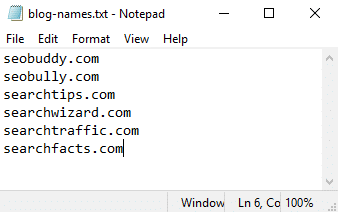
It’s good to add the .com to the end of your name because you are probably going to want to use the same name for your domain. If your blog is in English, the .com domain extension is best.
You can use NotePad on your Windows computer, or the Notes app on a Mac, which also happens to sync with your iPhone.
It’s also a great idea to have a form of the note document on your phone. The chances are that ideas will start popping up into your head at random times once you put your mind in “brainstorming mode.”
The next time you get in front of your computer, you can take the name ideas from your phone and write them down in the main document on your computer.
You can also use an app like Evernote or Microsoft OneNote, which syncs between devices.
It could be good to write down 50-100 names, or even more. The more you write down, the higher your chances are of finding the perfect name.
Most importantly, give yourself plenty of time to find the perfect name. You don’t need to make a decision right away.
Bottom Line: Create a text document with a list of different blog name ideas. Also, write down names on your phone when you think of good ones.
2. Write down your main keywords
Next, I recommend writing down the main broad keywords of your niche.
If you are writing about SEO, then these could be SEO, search, rank, links, etc.
For a website about sleep, it could be sleep, rest, slumber, snooze, etc.
Try to find all the words that make it clear what niche or industry your website is in. People looking at just your blog name should see clearly what the topic of the site is.
Put these keywords into your text document, like this:
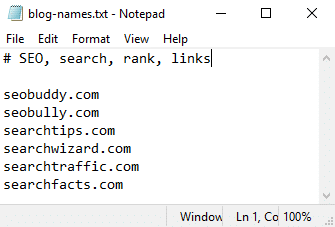
When you continue brainstorming, you can consider these words for inspiration.
Bottom Line: It’s a good idea to write down all the words that clearly describe the niche or industry your blog is in. You can base your blog name on one or more of these words.
3. Keep in mind these characteristics of good blog names
Blog names are like brand or company names, and the good ones have specific characteristics.
They are the same as the characteristics of good domain names because your domain name will likely be based on your blog name.
Relevant
Having a blog name that sounds relevant to your main topics is crucial.
One of the reasons is search engine optimization (SEO). When people search for stuff online, they often consider the site and domain name before clicking on a search result.
If your name looks relevant to your topics, then it will get a higher click-through rate from search engines, which leads to more traffic.
Easy to spell, say and remember
Your blog and domain name need to be easy to:
- Spell: So that people can return to your site again easily by writing the name directly in their browser.
- Say: The name should roll off the tounge when spoken out loud.
- Remember: If the name is memorable, then it will help people find your site again. It can also help with word-of-mouth advertising.
It is important to avoid using words in your blog name that are prone to spelling errors. This includes words like byte/bite, lose/loose, etc.
Not too long
Consider the best brand names in the world — Apple, Facebook, Google, Coca Cola, Nike, Adidas, and others.
Most of them are short, usually in the range of 1-4 syllables.
So, try to find short blog names. The fewer syllables, the better.
No numbers or hyphens
It can look untrustworthy when blog and domain names have numbers or hyphens in them. There are some examples of successful sites that include them, but they are not many.
Make sure the .com domain is available
If you are writing a website in English, for a global audience, then you should try to get a .com domain name if possible.
People are more likely to remember .com domain names, and they find them more trustworthy.
Because of these, .com domain names may have small indirect benefits for traffic and SEO.
Bottom Line: Good blog names have the same characteristics as good domain names. They are short, memorable, easy to say and type and relevant to the main topics of the site.
4. Consider the different types of blog names
There are many different types of blog names.
It’s good to consider all of them and brainstorm ideas for each type.
Keyword + second word
One popular type of blog name is using one of the main keywords of your niche, then adding another word either before or after.
For example, SEO (search engine optimization) is one of the main topics of this website. For this reason, “search” is one of the main keywords.
I use the words “Search” + “Facts” and the domain name searchfacts.com, which also happens to be short and easy to remember.
My previous website was called Authority Nutrition, where “Nutrition” was the main topic but the word “Authority” was added in front to show that it was a science-based website.
Here are more examples of these types of blog names:
- Problogger: Pro + Blogger
- WPBeginner: WP (for WordPress) + Beginner
- Blogging Wizard: Blogging + Wizard
- Healthline: Health + Line
- PaleoHacks: Paleo + Hacks
These second words can add a specific tone to your blog name and help with branding.
Examples of words to use include tips, hacks, facts, pro, beginner, wizard, today, line, daily, now.
Your name
Many bloggers have had success in building a personal brand using their name as the blog name.
One benefit of this is that it can give you a little more flexibility in the topics you write about since the name is not niche specific.
More types
Here are several more types of blog names for you to consider:
- Made-up: Names that seem mostly made up. Examples include Moz, Twitter, and Google.
- Add ly to the end: Many companies have simply added “ly” to the end of a word. Examples include Optimizely and Namely.
- Different language: Using a word from a different language can sometimes work, as long as it is short, easy to remember and spell.
- Abbreviation: If you want to use a name that is several words, then you could choose a domain name that is an acronym.
Bottom Line: There are many different types of names you can consider for your blog. It is useful to brainstorm a few ideas for each type.
5. Use Thesaurus
A thesaurus is a book or online tool that lists synonyms and related words. It is a handy tool when coming up with new blog names.
You can use it to find words related to the ones you thought of yourself.
For example, if I wouldn’t have been able to get the domain searchfacts.com, I might have used a thesaurus to find a word to use instead of “facts.”
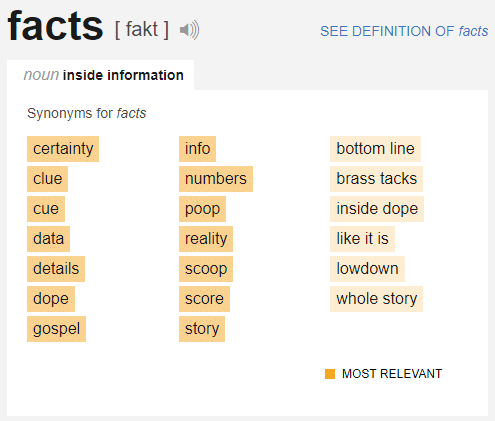
Try typing words and concepts you want to use in your blog name into the online thesaurus.
The chances are that you will find great words that you would never have thought of otherwise.
Bottom Line: You can use a thesaurus to find words that are related to the words you were already thinking of.
6. Enter your keywords into Nameboy
Nameboy is a popular blog name generator. It works by adding a bunch of common secondary words in blog names before and after your primary keyword.
To use it, start by going to Nameboy’s website.
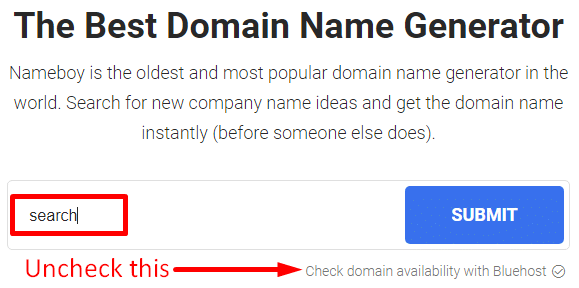
But make sure to uncheck “Check domain availability with Bluehost” — Bluehost is not a good web hosting company.
I recommend that new websites use Siteground instead, while established websites with steady traffic should use Kinsta.
Here’s what results show up when I add “search” to Nameboy:
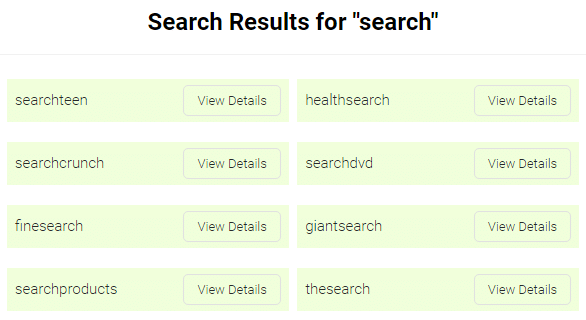
Make sure to write the ones you like into your text document with the list of ideas.
Bottom Line: Nameboy is a useful blog name generator that works by adding popular words before and after your keyword.
7. Try the Wordoid blog name generator
Wordoids are made-up words that look and sound like they could be real words.
Using the Wordoid name generator, you may be able to find clever blog names that are made-up versions of your main keywords.
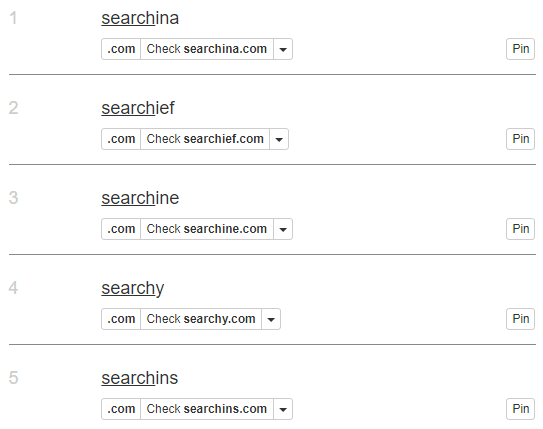
Most of the wordoids will seem silly, but you may be able to find a few excellent ones that are worth considering for your blog name.
Bottom Line: Use the Wordoid name generator to come up with made up words that are based on your main keyword.
8. Use Panabee
Panabee is another free tool to help you discover blog name ideas.
You enter two words that describe your blog, and the tool gives you a ton of domain name ideas based on the words.
Then you can click the broken heart icon to show only the available domains at the top.
Bottom Line: Panabee is a useful blog name generator that can help you find good names with available domains.
9. Narrow down your selections and register the domain
If you have gone through all the steps above, then you should already have a long list of blog names to choose from.
Now, you can narrow down your list until you find the name that you want. Make sure to check that the domain for your name is available.
Once you have found your blog and domain name, you should register it using either of these two options:
- Siteground: If you plan on building your site right away, you should register your domain and get web hosting at the same time. Siteground web hosting is great for beginners.
- NameCheap: If you just want to buy the domain and not build a site any time soon, then I recommend using the domain registrar NameCheap to register the domain.
If you have found a good .com domain name, then you should register it immediately.
Good domain names are in high demand and you need to reserve it before someone else grabs it.